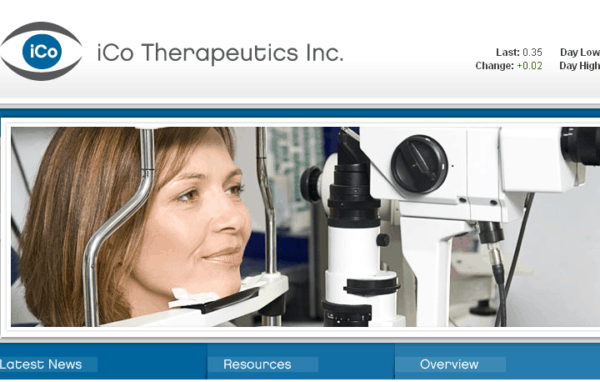iCo Therapeutics CEO Andrew Rae talks to Cantech Letter


iCo Therapeutics (iCo Therapeutics Stock Quote, Chart, News: TSXV:ICO), which was founded in 2005, is a biotech that focuses on redosing or reformulating drugs that already have a clinical history.
The company, which owns the exclusive worldwide rights to two products, iCo-007, a treatment for Diabetic Macular Edema and iCo-008, a treatment for severe ocular allergies and Wet Age Related Macular Degeneration, grew out of the shadow of Vancouver’s QLT Inc, and took advantage of the specialized and newly available talent as that company splintered, and its Visudyne product was acquired by Valeant.
After a torrid 2012, shares of iCo have cooled off this year. Cantech Letter’s Nick Waddell recently talked to iCo CEO Andrew Rae about why the investors should take another look at the company.
Andrew, can you tell us how iCo got its start?
iCo Therapeutics was founded by Management after the last start up I was involved with was sold to the antibody company Medarex, subsequent to its early-staged development of a drug (MDX-1100) for autoimmune conditions (later Medarex was acquired by BMS for over $2BN). After this very positive trade sale, our team started looking at the wild success of QLT Inc. which developed Visudyne, the first treatment for wet macular degeneration.
It seems that because of QLT there was a lot of world class expertise in the Vancouver area for you to source …
Absolutely. We wondered why other ophthalmic ‘start ups’ had not been seeded in Vancouver given the enormous human capital in our back yard. As a former biotechnology analyst I always had looked for very specific human expertise, which is extremely important in development of a successful start up. Clearly we’ve been able to access some of that talent, including our Chief Medical Officer, Peter Hnik, who was involved in Visudyne studies before joining us. He is tapped into some of the best retinal specialists on the planet, several of whom are involved in our key study.
How would you characterize iCo’s business model? Are you looking to bring products to market from the earliest stages, or are you looking at mature offerings?
This was a thoughtful consideration before launching the company. We considered a business model which would focus solely on three functionalities: clinical/regulatory development, finance, and business development. We effectively run the second and third legs of the 4X100 of drug development by licensing assets, taking them quickly into earlier clinical development, and then seek partners for final clinical trials and marketing, thereby capturing great value creation and minimizing development risk, assuming all goes well.
Can you tell us about your product pipeline?
iCo-007 is a drug which targets something called C-Raf kinase and we are testing its effectiveness in diabetic blindness, otherwise known as diabetic macular edema (DME). Over 20% of diabetics suffer from visual impairment. We believe that there is great potential for differentiation of this product in that the drug targets other factors potentially involved in the disease process – many patients are not responding well to the one approved drug on the market. iCo-007 also displayed a good safety profile in our earlier Phase 1 study and at our current study mid-point. As an example, competition to us, including steroid use, has been known to cause glaucoma and cataract formation. Additionally iCo-007 appears to have a very long treatment effect, and is cheap to manufacture.
iCo-008 addresses orphan or smaller markets such as vernal and atopic conjunctivitis (VKC, AKC) but these markets are poorly addressed by current treatments such as cyclosporine and steroids. It is a very targeted antibody supported by very strong scientific literature and has a clinical history in 126 patients. Recent literature has indicated it may also be considered as a potential candidate in the development of a third wave of products for wet age-related macular degeneration.
Oral Amphotericin B is a non-core asset but is both a delivery platform for highly insoluble products and a reformulation of a potent generic antifungal drug. Recently we have received new patents for this candidate and platform in several countries. Gilead has a product in this arena which historically has sold hundreds of millions of dollars per annum but it is limited to acute settings and an IV line, whereas we are developing an oral version that broaden the number of potential treatment indications without infusion-related side effects.
What is the market potential for iCo-007? What about iCo-008?
Given the explosive increase in diabetic population and the “aging” demographic, the market for iC-007 is significant. By way of comparison, Eylea, a product that was recently introduced to the wet age-related macular degeneration market (Wet AMD), a “sister” disease to DME, posted revenue of about $838 million in 2012, the first year of introduction, and $314 million for Q1 2013. And that was based simply on being able to reduce the frequency of patient injections from once a month – the typical treatment regime using the current standard of care, a drug called Lucentis – to once every two months using Eylea. We believe iCo-007 can reduce the injection frequency even further, and has other advantages in product differentiation as well.
For iCo-008, the VKC/AKC markets are much smaller, but the advantage is being able to price a product at a premium given the lack of competition and hence create a highly profitable drug. Gilead was very successful with this business strategy. Further, iCo-008 has additional applications in other systemic inflammatory related diseases, such as ulcerative colitis and asthma so there is a meaningful opportunity to generate revenue across a number of disease indications.
We are meeting all the right players interested in eye diseases. We want the right deals, and the right partner or partners. So we continue to have discussions in earnest with respect to our clinical staged assets
Can you tell us about some of the partnerships you have already undertaken?
We are very proud of our partnerships, which include Isis Pharmaceuticals, a roughly $2BN NASDAQ listed company, AstraZeneca, a global pharmaceutical player, and JDRF, the world leader in type-1 diabetes research.
In our partners we find great leverage. Isis has an enormous patent estate to which we have access. They have led a financing and taken cash payments in equity. They also manufacture drug product for us. JDRF allows us to access the same networks and clinicians Genentech utilized for the Lucentis trials, and also to reduce our clinical-trial cost significantly.
What does your cash position look like in relation to your burn rate?
We announced the closing of a financing on May 21, 2013. If you look at our July 2012 financing of roughly $2.5M, we were able to take that cash, with proceeds from some additional warrants exercised, and conduct our activities until today. In the process we’ve been able to recruit and treat an enormous patient population for our Phase 2 iDEAL study. JDRF allows us to reduce the total study cost by roughly 40% and we carefully manage our treasury focusing capital primarily on iCo-007 and operations. So we are pleased that an additional $3.4M gives us significant runway through key milestones.
What kind of milestones should investors look for from you in the next 12-18 months?
Look for primary end-point data for the iCo-007 Phase 2 iDEAL study –visual acuity at eight months in a very large population. Our last related press release noted over forty patients per treatment arm (n=174), arguably on par with Genentech’s READ-2 study of Lucentis. Genentech’s drug Lucentis is currently the only approved drug in the US for DME and is a blockbuster therapy. Notably JDRF, our partner with iCo-007, was involved with the development of Lucentis.
Investors should also watch for primary end-point data for an iCo-008 Phase 2 ulcerative colitis study run and financed by our Israeli partner, Immune Pharmaceuticals. They have announced initiation of the study in 90 patients in Israel and we should hear more about that development as they progress. They have also proposed a merger with a NASDAQ-listed company. We hold a significant percentage of Immune and are also owed $32M in milestone payments as they progress through product development. We also maintain rights to uses in the eye for this candidate, which has become the focus of several discussions with pharmaceutical companies interested serious eye allergies and macular degeneration.
Investors can also look for further confirmatory studies related to our Amphotericin B delivery system. We are working with a generic drug and attempting to convert the formulation from intravenous to oral. We know the drug works, we need to re-examine its safety profile in this formulation as well as investigate potential intriguing uses of this drug for non-life-threatening fungal infections and life-threatening parasitic infections. It is the later use which has become very interesting to the Gates Foundation and other granting groups that have helped finance this program with minimal dilution.
Finally, look for more partnerships. We are meeting all the right players interested in eye diseases. We want the right deals, and the right partner or partners. So we continue to have discussions in earnest with respect to our clinical staged assets. In the area of retinal diseases, on which iCo-007 is focused, we have seen recent deals in the range of $25-45M upfront and hundreds of millions in milestone payments and royalties through development.
Nick Waddell
Founder of Cantech Letter
Cantech Letter founder and editor Nick Waddell has lived in five Canadian provinces and is proud of his country's often overlooked contributions to the world of science and technology. Waddell takes a regular shift on the Canadian media circuit, making appearances on CTV, CBC and BNN, and contributing to publications such as Canadian Business and Business Insider.


